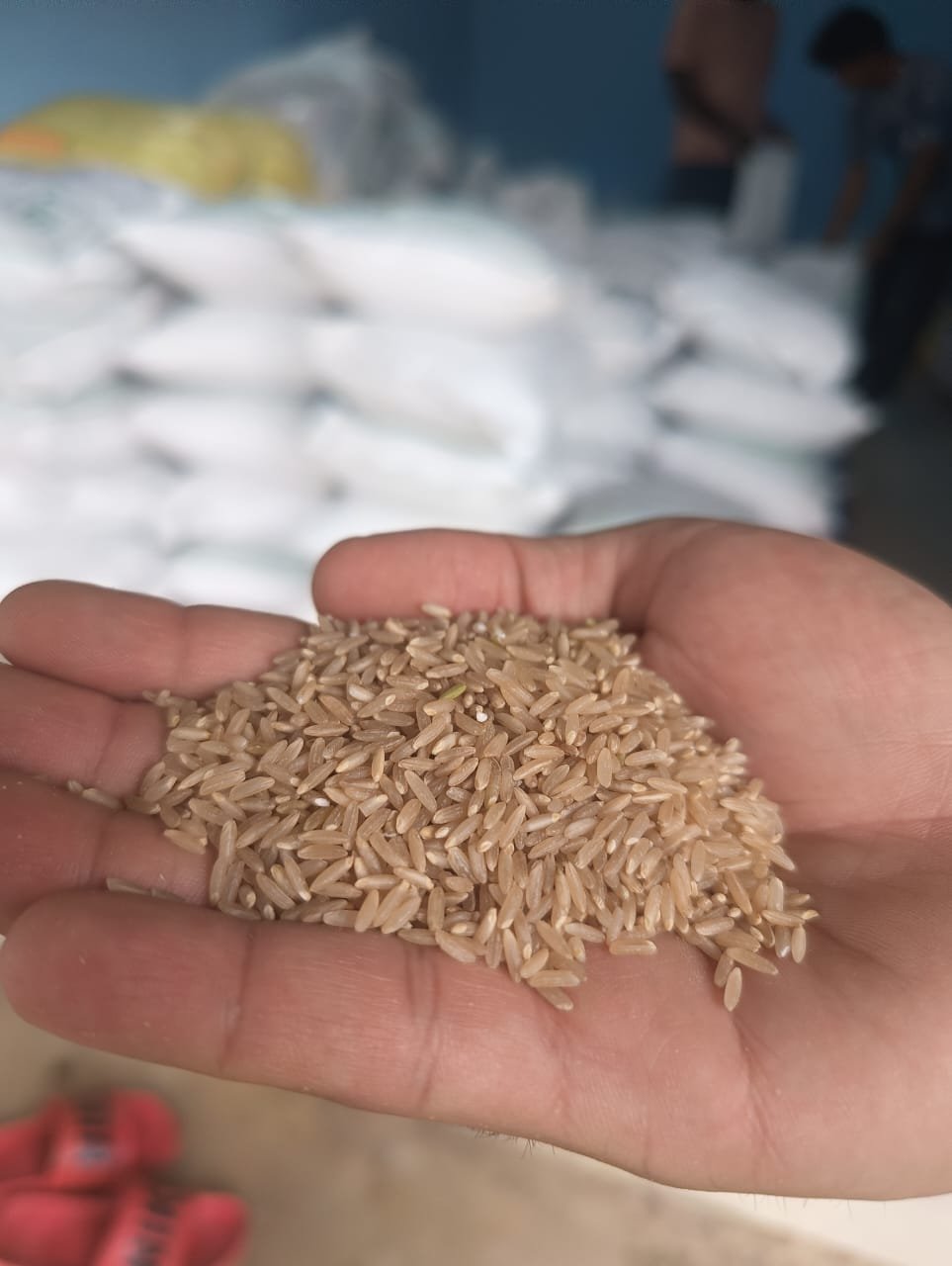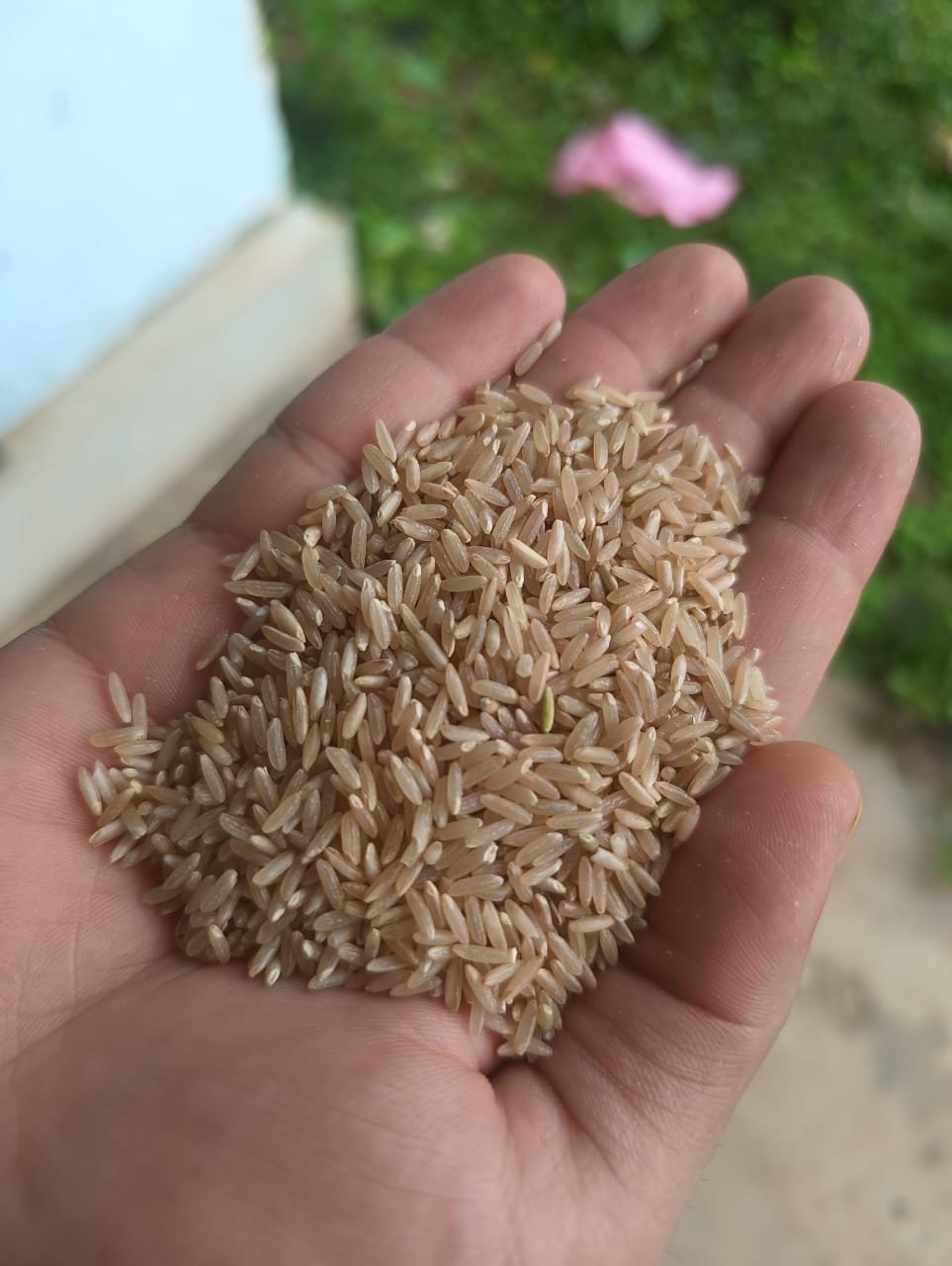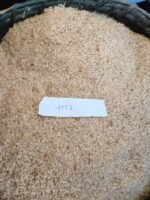HMT Rice
HMT Rice is a short grain daily rice variety, developed through natural selection by the experimental farmer Dadaji Khobragade.
Dadaji who was from the Chandrapur district in Maharashtra, developed this rice variety as a naturally high yielding variety with a low glycemic index.
Our HMT rice is grown from seeds received from Dadaji himself, therefore it is the original variety itself. HMT rice can be consumed as a replacement to Kolam rice for daily consumption.
From ₹199.00
SKU:
N/A
Categories: Food Products, Rice
0
People watching this product now!
- Dadaji Ramaji Khobragade (65) grew up in a small forest village called Nanded in Naghbid taluka of Chandipur district in Maharashtra. He left school after the 3rd standard due to adverse economic conditions and also because his help was necessary in the farm. Currently, he is the only earning member of his family, which comprises his son (who does not earn due to his ill health), his daughter-in-law and three grandchildren. He owns 1.5 acres of land and his income is Rs.12, 000 per annum. At present Dadaji Ramaji also cultivates three acres, once given to his son by a relative.He had to sell two acres due to the illness of his son. Occasionally he works as a daily wage labourer to support his seven-member family.
Genesis In 1983 Dadaji Ramaji noticed three yellow seeded paddy spikes commonly called as ‘lomb’ in 1.12 acres field, planted with the Patel 3 variety of paddy. He picked these three spikes, brought them home and stored them in a plastic bag. The next year he sowed the seeds of this yellow variety separately in the middle of his field. As his field was close to the jungle he planted the rice amid a fence of thorny bushes to protect it from pigs and other wild life. Observing the high yield of this variety, he preserved the seeds. The following year he cultivated the seeds separately and got nearly ten kilograms of husked rice. On cooking the seeds he found them to be tastier than the Patel variety.
In 1988 he sowed four kg of seeds in an area of 10 ft X 10 ft and produced 400 – 450 kg of rice. The next year 100 – 150 kg seeds were sown from which he obtained 50 bags of paddy and he sold the seeds (40 bags) to one of the traders at Nagpur. Since the name of the variety was not known, the trader purchased the seeds in the name of Swarna Sona. Soon he began distributing this new variety to local farmers on their demand.
In 1990 Bhimrao Shinde, a large land owner in Nanded, bought 150 kilograms of seeds and sowed it in four acres of land. He obtained 90 bags of yield and sold the same to a trader from Talodi. The trader gave the name HMT to this variety as HMT watches were very popular at that time and he had recently acquired a new one. Ever since the name HMT has stuck.
Current status
Dadaji Ramaji contacted the paddy research centre regarding this variety, but they refused to recognize his farm research, as it was not based on scientific research techniques. But in 1993, the Gram Panchayat of Nanded passed a resolution in their meeting recognize the work done by the farmer and acknowledge him as a Paddy Seeds Producer. received public recognition for the first time by Vilasrao Mutyan, the then MP (1993) of Chimera constituency, who felicitated him on the occasion of the inauguration of a statue of Indira Gandhi at Nanded in 1994. He also felicitated by the BDO, Nagbhid on the occasion Krishi Melawa (Agro meet) in 1994. After publication his work in newspapers, a letter from the Collector Chandrapur to Punjabrao Krishi Vidhyapith (Agricultural University, Akola) lead to him getting recognition by Dr. Moghe and then Directorate of Research, PKV, Akola. Now most of the farmers in the Vidharbha region have started growing this variety as it fetches them a better price and has improved their economic situation. is visible, as Dadaji Ramaji puts it: “Their thatched roofs transformed into tiled roofs – a sign of prosperity”. variety is now being marketed in Andhra Pradesh, Gujarat, Chattisgarh, Madhya Pradesh and Maharashtra.
A bitter experience
In 1994 Khobragade was approached by the Sindewahi Rice Station, a part of Punjabrao Krishi Vidyapith. It took five kilograms of seeds of the new variety under the pretext of experimenting. But in 1998 they released a new variety named PKV HMT. They claimed that Khobragade’s variety was ‘impure’ and that they purified the local HMT and released it under its new avatar called PKV HMT. To Khobragade there is no apparent difference between his and theirs.
This classic case of formal science refusing to acknowledge the achievements of the informal was published in The Hindu newspaper. According to the report, Mr. A.D. Bhombe – Assistant Professor Botany at the Punjabrao Deshmukh college of Agriculture at Nagpur who was earlier a senior rice breeder at the Sindewahi rice station – clarified that the original selection of HMT was made by the farmer. But he went on to explain, “We felt that this HMT was a mixture and it needed to be purified. The seeds were collected from this farmer and we purified it. Farmers cannot maintain individual plant selections over the years. In the farmer’s method, there is some chance of natural crossing.”
Several social activists like Ashish Kothari and others felt that the university had not been fair to Dadaji Ramaji. Several journalists wrote about his travails and pleaded for better recognition to him. Meena Menon, a journalist from Mumbai wrote to NIF highlighting the saga of struggle that Dadaji Ramaji had gone through to get due recognition from the formal system for such a useful research.
Vikalpa, a NGO from Nagpur wrote to NIF in December 2002 enclosing detailed information about the research by Dadaji Ramaji. They provided the entire history and series of events from 1983 till 2001.
Dadaji Ramaji, the innovator complains: “Now these new seeds are sold for Rs.1200 a quintal. What have I got out of all this? The government wants to deprive me of any credit and the variety they claim to have released is exactly like mine.” (The Hindu, 17/6/ 2001).
An indomitable spirit
But undeterred by this experience with the establishment, Dadaji Ramaji does what he enjoys most; he continues in his father’s footsteps. His father had a habit of selecting and breeding crops which young Dadaji had often observed and later picked up. His father used to take the grains in his hand and grind them between his palms like an expert and observe the number of broken grains to judge the quality. The young boy was so enamoured with the idea of cultivating new varieties that he became obsessed with it. He would even carefully pack the new variety in polyethylene bags and show it to his friends.
Pursuing this passion, Khobragade has selected and bred seven more varieties of paddy in the last 20 years namely Chanaur, Nanded 92, Nanded Hira, DRK, Vijay Nanded, Dipak Ratna and a new unnamed variety in the year 2001 apart from HMT. The average yield of all the new varieties is about 15-16 quintals per acre. Out of these eight varieties, Vijay Nanded yielding 25 bags/ acre and HMT 20 bags/ acre have been commercially successful. One variety is mildly scented. Khobragade named another variety DRK after himself. Just as in childhood, he proudly displays each variety he has carefully framed and labelled.
At the same time, harsh reality makes him express his hope of being rewarded for this innovation. He says he would spend the award money to buy a pump set and a pair of bullocks, as presently he has to hire bullocks to till his farm. He would also like to improve the condition of his dilapidated house. But on the subject of his ambition he declares his wish of sharing ideas with other farmers and feels “If other agriculturists follow my way of working in the field, it would result in higher yielding varieties and better prices for the crop.”
The paddy variety
Dadaji Ramaji selected and bred the HMT rice variety from the conventional ‘Patel 3’, a popular variety of that time developed by Dr. J. P. Patel, JNKV Agriculture University, Jabalpur. He succeeded after five years of continuous study and research on a small farm owned by him without any support from the scientific community. It has an average yield of 40 – 45 quintals per hectare with short grains, high rice recovery (80 %), better smell and better cooking quality in comparison with the parent ones
| Qty |
1KG ,5KG ,10KG ,20KG |
|---|
Customer Reviews
Rated 0 out of 5
0 reviews
Rated 5 out of 5
0
Rated 4 out of 5
0
Rated 3 out of 5
0
Rated 2 out of 5
0
Rated 1 out of 5
0
Be the first to review “HMT Rice” Cancel reply










Reviews
Clear filtersThere are no reviews yet.